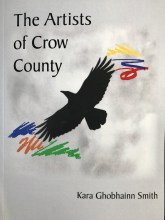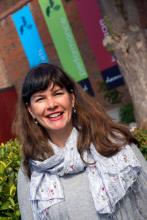What first struck me in this unusual book of poetry is that it wrestles with art in more than one way, providing colour pictures of seven paintings, seven photographs, and two drawings as well as the poems. These colour images set between the texts make for an appealing, if quixotic book. The reader gains a sense of fullness as they move through the pages, the images playing with the reader’s impressions, and interacting with the poems. This book is both chimerical and suggestive, the lines of poetry sometimes suggesting visions.
Kara Ghobhainn Smith is not a simple person. Smith was the Chatham-Kent Writer in Residence for 2016. In addition, working in more than one realm, she is an award winning university teacher, a book review editor, an author of two academic texts and a memoir as a hockey mom, a poet, and a blogger. She is also a devoted wife and a mother, living in the Chatham-Kent district Southern Ontario.
Smith is to be admired for what she has done, working in multiple languages, exploring history and culture in North America and Europe. Her work ‘in the real world’ seems to invade her writing appropriately. She appreciates art as a human expression. She writes involved poetry.
When human beings first began to make art, it was not immediately appreciated as something separate from the utilitarian and ceremonial vessels it adorned. In fact, image-making was understood to be a transfer of mystic powers that were interwoven with day-to-day life and rituals. It took thousands of years for art to be separated from the daily lives of ordinary people. Smith appreciates this, looking backward in the way of an archaeologist, but drawn forward in contemporary exhibitions. She draws upon ideas that paint an older function of art, while weaving her poetic inspiration with descriptions of contemporary, local paintings.
The images she creates are ethereal. There are several poems that evolve with ripe, unusual imagery, use of breath, and juxtaposition (Where Rhinos Fly, Flats♭ and Sharps♯, I’m growing things. A baby and vegetables).
‘I’m growing things. A baby and vegetables’:
First, a wee heart of hemp,
beet by beet with the
sweet liquid of the sun.
Innate food of the earth seeping into
small passageways to
transfigure the seed into
lungs of leek, and carrot-coloured
kidneys, tiny turnip
branches of our family
(I’m growing things. A baby and vegetables)

There are also poems that demonstrate the strength discovered through combining the arts She shows how a painting can inspire fluid poetry through the artist’s interpretation of the visual arts, using the paintings like a map to describe a personal journey:
The movement leaps and
jumps around the altar as the
colours search for their counter
points and partners across the
cave’s centre.
(Melanie Morgana)
Smith demonstrates her skill in using this combination to enrich both the painting and the poem. Yet, it is not only by interpreting the visual arts that Smith demonstrates her own connection with the process of creation. A poem can also offer an interpretation of both the action and the elements that create glass art:
Jason, like Gepetto before him,
gently gathers a gob of swirling
zygote, like honey on the end of
a wand, turning to keep it latched.
He dips it into a petit bundt
mould, giving it edges, a core
of ridges to form a heart
and life.
(Glass Birth)
One sees a theme in these poems. I found the title of the book evocative. The Chatham-Kent area is resplendent with crows, suggesting part of the reason for the title. While a gathering has poetically been called ‘a murder of crows’, perhaps where large numbers proliferate most other species simply vacate. Crows are drawn to urban centers, using their ability to communicate combined with problem solving to out-pace other species, dominating the area. In the fields of magic and art, crows are credited with mystical importance, much of it associated with dark deeds on All Hallows Eve.
First Nations consider crows to be Keepers of Sacred Laws, a Police force in the natural world, or a Trickster that warns you to beware of deception. Indeed, if Crows have a weakness, it might be their affliction for collecting, their thievery of shiny objects. Science has recently proven the crow is smarter than the average bird – its forebrain organized into clusters rather than layers – the size of its brain compared to body mass distinguishing it among bird species. Yet, Chatham-Kent is not distinguished by large urban centers, which leaves one asking, what is it that draws crows to the region? How has it become known as Crow County?
You will not find the answer to that question in this book. A glance through this book suggests Chatham Kent also has a number of important artist galleries that feature the work of important artists. The poet is not speaking of classic paintings but contemporary art shown in local galleries. She writes about her impressions of a variety of paintings at openings for exhibitions. These facts might suggest a different part of the answer to how the title for this book was arrived at, but simple answers are often not sufficient to tell us why such a reference was created.
There is much to admire in this collection. Smith speaks to specific exhibitions in May, September, October and November 2015 in Chatham-Kent. She includes poems about images shown in local galleries in January, February, March, April, May, June, July, and August 2016. Her social life must be very busy! Throughout this books, she makes references to writers, gallery curators, several species of birds, architecture, the strife of working in education in the past several years, seeing older relatives reflected in her son, the development of her child’s social mask, being a foreigner, wine-making, exotic foods, music, being Canadian, foreign cities, and the making of art. Her poetry, and her personal operation in this world, seem to exist in so many places at once!
There are some rough edges in this collection that slice like paper cuts though. Those slices are a collection of annoyances that add up to something larger, an over sight. I admit to being a stickler for expressing the important truths. It bothers me to find there are inconsistencies with a story that presents itself as a truth. The first poem and painting in the book suggest Smith has tried to provide an answer to the issue of crows in the title. It faces a painting by Leonard Jubenville, who created a snowfield inhabited by crows gathered on A Patch of Grass, with a tree and fallen snow fence. In her poem, Kara Ghobhainn Smith tells us:
Our stake in this
landscape is steadfast.
Faithful as le vieux pays,
for 20 million years we have
watched rows of gladiolus, conifer
and corn reach and recede
alongside the frozen waters
of the Erie-Thames.
(Crow County)
Her poem seems to assert the proper order of things, including the inherent supremacy of plant and animal entitlement to exist in their natural habitats. The problem is that the list of facts she supplies is wrong. Crows existed in North America before settlers arrived, but were found only in the east, their population growing and spreading west with European colonization. In addition, Gladiolus may have appeared in settler gardens, but they are native mostly to Africa with just 10 of 260 species found in Eurasia. What’s more, though corn was developed from a wild grass called teosinte in Central Mexico about 7,000 years ago, it could not have arrived in the Chatham-Kent region until after the retreat of the Ice Age glaciers some 9,000 years ago.

Another example of those paper cuts is found in several titled works (e.g., ‘The Canadian’ in Eight Movements) and a few untitled poems (e.g., “She could tell you were English”). I reread those pieces, several times, in an unsuccessful attempt to decipher their meaning. I simply could not find a satisfactory resolution to my questions. Then there is the error in possibilities presented when she says, ignoring the time frame for either gardening or fashion:
Still under,
their smooth white steps
carry children playing,
Potted geraniums or
women in red stilettos.
Expertly unchanged
for 3,000 years.
(Agape Grounded)
Yet, Smith should not be over-looked as a poet She is not afraid to experiment with her phrasing, line breaks, spacing, form, or line direction. At times I am amazed by the beauty in her phrases such as “triggered blood-tie ripples into the world” (I Walk the Hypersurface), “silk-spun eyes” (Homegrown), “in an earth untorn/ by cultural clear-cutting (Splitting Worlds).
Smith is keen to draw on history and bring it forward, to articulate a blend of cultures, and to interweave time gone by with the present as she does when observing that same glassmaker create his art:
Colours are added from the sulphides
and oxides of the Earth: blue
from the cobalt, sun yellow from
the cadmium, and a red of
Mesopotania’s ancient gold
chloride.
(Glass Birth)
This is a book that is worth the paper cuts. It points to what Kara Ghobhainn Smith will accomplish in the future.
- By Sharon Berg, February 17, 2017

Aucun commentaire:
Publier un commentaire